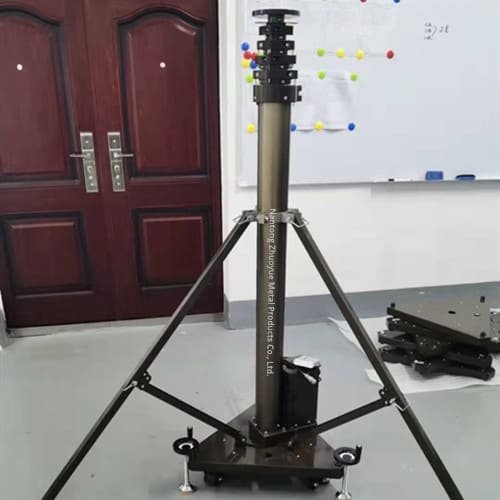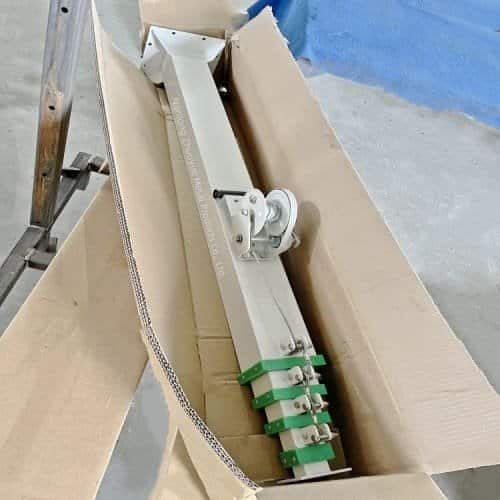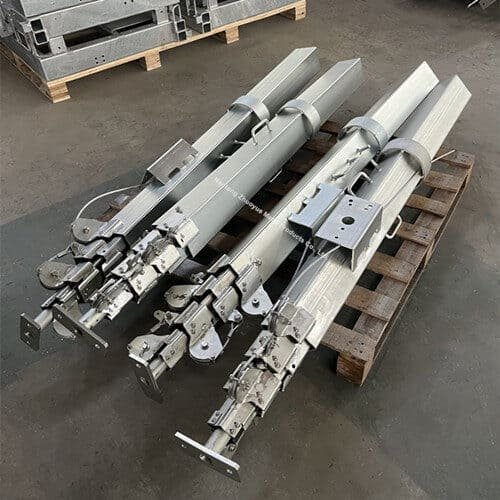Telescopic Mast Systems: Precision Lift Solutions for Surveillance, Lighting, and Communications
From manual winch-up masts to high-load hydraulic towers, tailored for mobile missions, field operations, and permanent installations.
Table of Contents
Introduction
Telescopic mast systems play a critical role in modern field operations—enabling elevation of cameras, antennas, lights, sensors, and communication gear in demanding environments. Whether for surveillance, broadcasting, defense, or emergency response, choosing the right mast system ensures reliable performance, rapid deployment, and long-term stability.
This article explores the four major types of telescopic mast systems, their use cases, technology principles, and key selection considerations to help integrators, OEMs, and public safety professionals find the optimal solution.
Why Telescopic Masts Matter
Whether stationary or mobile, telescopic masts are essential for:
Elevating equipment above obstacles for line-of-sight
Supporting high-mounted payloads with stability
Allowing fast deployment and retraction
Operating in remote or infrastructure-limited zones
From disaster zones to urban events, the right mast maximizes visibility and signal coverage—making them indispensable across many sectors.
Types of Telescopic Mast Systems: Choose the Right One for Your Mission
🛠️ 1. Winch‑Up (Manual) Telescopic Masts
Manual winch-up masts are lightweight and cost-effective, relying on hand-operated winches and cables to extend the telescoping sections.
Key Features:
No electricity or compressor needed
Simple maintenance and low failure rate
Max height typically under 10 meters
Best For:
Entry-level surveillance trailers
Temporary event monitoring
Budget-conscious deployments

💨 2. Pneumatic (Pump‑Up) Telescopic Masts

Pneumatic masts use air pressure to extend and retract tubes, typically powered by electric or manual air pumps.
Key Features:
Smooth vertical extension
Lightweight aluminum tubes
Fast deployment and low friction
Best For:
Lighting towers
Camera masts for vehicles
Light to medium payloads
Note: Requires pressure monitoring; less suitable for very heavy loads.
🔧 3. Mechanical / Electro‑Mechanical Masts
This category includes motorized, mechanically-driven systems for heavy-duty applications requiring precise control, stability, and high extension.
✅ 1. Linear Actuated Telescopic Masts
Use electric linear actuators to raise mast segments individually or in sync.
Ideal For:
Fixed installations
Autonomous deployments


✅ 2. Cable-Driven Telescopic Masts
Utilize internal cable-and-motor systems to raise the mast through synchronized pulleys or gears.
Ideal For:
Integrated vehicle systems
Mobile command units
✅ 3. Hydraulic Telescopic Masts
Powered by hydraulic cylinders, these masts offer robust lifting power and are ideal for high-load payloads and adverse conditions.
Ideal For:
Surveillance trailers
Radar and communication towers
Military-grade applications
Advantages Across Mechanical Systems:
High payload capacity
Controlled extension and stability
Suitable for tall mast requirements (10m+)

🧳 4. Tactical / Vehicle‑Mounted Masts

Compact, ruggedized mast systems designed for on-the-move operations and rapid deployment.
Key Features:
Fast elevation and lock mechanisms
Can be folded, stored, or roof-mounted
Ideal for mobile command and response units
Best For:
Emergency communications
Border patrol and military use
Surveillance vehicles and drones
Telescopic Mast Comparison Table
| Mast Type | Power Source | Max Height | Load Capacity | Best For |
|---|---|---|---|---|
| Winch-Up (Manual) | Manual | Up to 10m | Light | Budget field setups |
| Pneumatic | Air (Electric/Manual) | 5–15m | Light-Medium | Camera towers, light fixtures |
| Linear Actuated | Electric | 6–12m | Medium | Remote/Autonomous systems |
| Cable-Driven | Electric | 10–15m | Medium-Heavy | Integrated vehicle applications |
| Hydraulic | Hydraulic unit | 10–20m | Heavy | Heavy radar/camera installations |
| Tactical Vehicle-Mounted | Manual/Electric | 2–8m | Light | Fast-deploy field ops |
Real-World Applications of Telescopic Mast Systems
Emergency Response Units
Mobile Surveillance in Construction Zones
Military Communications Vehicles
Outdoor Events & Broadcasting
Border Control Checkpoints
These use cases highlight the versatility of mast systems across industries demanding elevation with speed, strength, and reliability.
Trends in Mobile Elevation Technology
Recent developments are pushing mast systems toward greater automation and environmental efficiency. Trends include:
Solar-powered integration for autonomous operation
Lightweight carbon and composite materials
AI-driven sensors for leveling and wind compensation
Modular mast bases for multipurpose deployments
Frequently Asked Questions
Q: What’s the difference between pneumatic and hydraulic masts?
A: Pneumatic masts use air pressure for lighter loads and quicker extension, while hydraulic masts use fluid-driven cylinders for heavier payloads and enhanced stability.
Q: Can masts be integrated on mobile trailers or vehicles?
A: Yes, tactical and vehicle-mounted masts are designed specifically for mobile integration.
Q: How high can telescopic masts reach?
A: Heights range from 2 to 20 meters, depending on the mast type and build.
Q: What kind of weather resistance do these systems offer?
A: Most systems can withstand moderate to high winds, especially hydraulic and mechanical masts. Protective finishes ensure resistance to corrosion and dust.
Choosing the Right Mast System
When evaluating telescopic mast systems, consider:
Payload weight and type
Desired elevation height
Power availability (manual, electric, hydraulic)
Frequency of deployment
Environmental conditions (wind, dust, terrain)
Engineering Support & Customization
Zhuoyue Metal Products provides OEM and ODM support for custom mast systems tailored to specific chassis, equipment, and regional standards. Our capabilities include:
Fabrication of mast base frames
Custom mounting brackets
Powder-coated finishes and weatherproofing
Hydraulic and actuator integration
Get Your Custom Telescopic Mast Solution
Whether you’re building a smart surveillance trailer or a mobile broadcast tower, our engineering team can support your mast system requirements from design to delivery.
